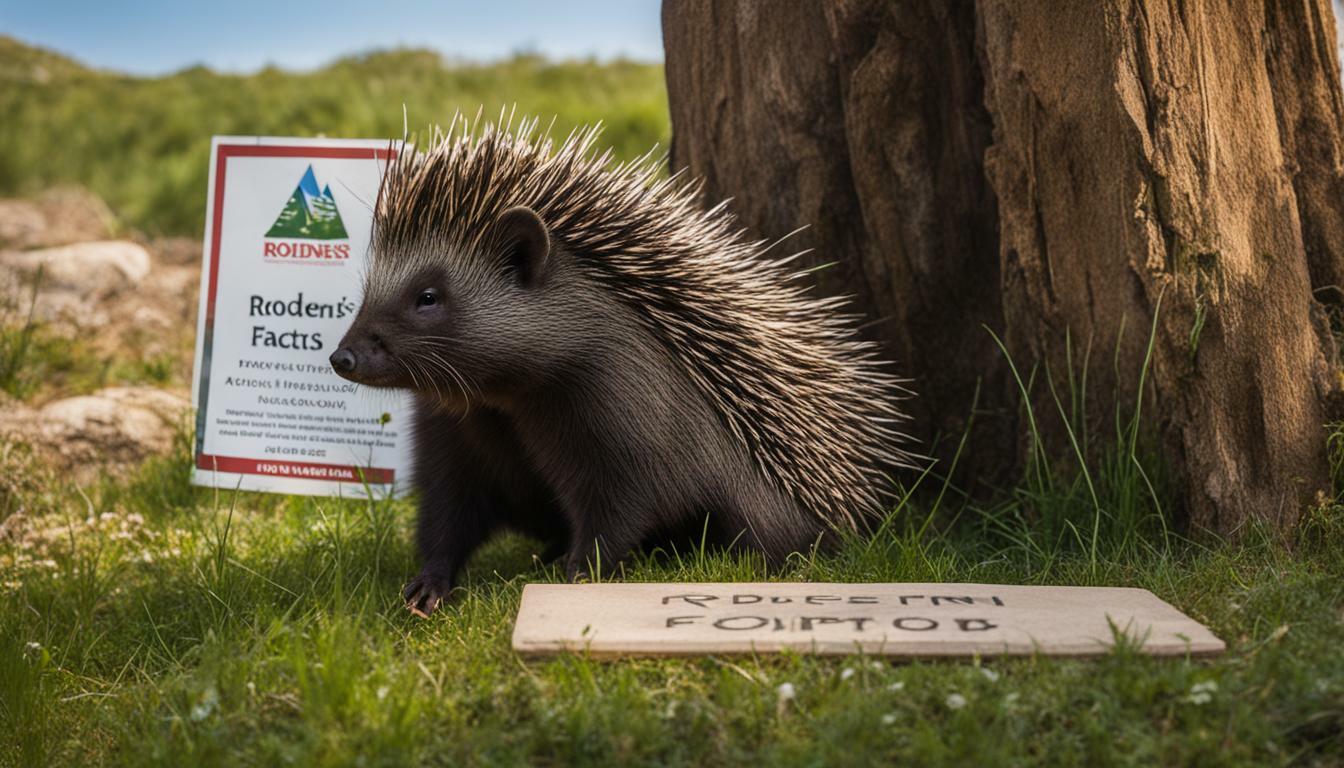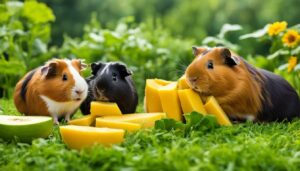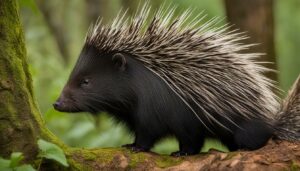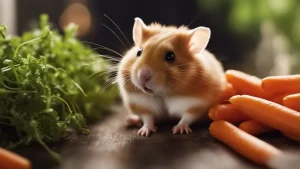Are porcupines considered rodents? Let’s find out the truth behind the classification of these fascinating creatures.
Key Takeaways:
- A porcupine is indeed a rodent and belongs to the order Rodentia.
- There are two families of porcupines: the Old World porcupines and the New World porcupines.
- Old World porcupines are found in Italy, Asia, and most of Africa, while New World porcupines are indigenous to North and South America.
- Porcupines have sharp spines or quills that protect them from predators.
- They are herbivores, primarily feeding on leaves, twigs, and green plants.
Porcupines have unique adaptations, such as their defensive quills and the ability to climb and swim. Despite their spiny appearance, porcupines are solitary animals and make their dens in caves, decaying logs, and hollow trees. They primarily forage at night but may occasionally venture out during the day. If threatened, porcupines will raise their quills and lash out with their tails. These quills have barbs that make them difficult to remove if embedded in another animal’s skin. Porcupines also use a wide variety of vocalizations for communication.
Understanding Rodents and Porcupines
To determine whether porcupines are indeed rodents, it is essential to understand the classification system of rodents and explore the different species that fall under the porcupine family.
Porcupines belong to the order Rodentia, which is characterized by the presence of constantly growing incisors. Rodents are the largest order of mammals, comprising over 2,000 different species. They are found all over the world, except in Antarctica and some oceanic islands.
There are two families of porcupines: the Old World porcupines (family Hystricidae) and the New World porcupines (family Erethizontidae). Both families belong to the order Rodentia and share similar characteristics, such as the ability to gnaw and the presence of sharp incisors.
The Old World porcupines are mainly found in Italy, Asia, and most of Africa. They have larger bodies and longer quills compared to their New World counterparts. On the other hand, the New World porcupines are indigenous to North and South America. They are generally smaller in size and have shorter quills.
| Order | Family | Genus | Species |
|---|---|---|---|
| Rodentia | Hystricidae | Multiple | Multiple |
| Rodentia | Erethizontidae | Multiple | Multiple |
In summary, porcupines are indeed rodents. They fall under the order Rodentia and are classified into the families Hystricidae (Old World porcupines) and Erethizontidae (New World porcupines). Understanding the classification and species within the porcupine family is crucial in determining the rodent status of these fascinating creatures.
Old World Porcupines
Old World porcupines are a category within the rodent classification system and are found in specific regions such as Italy, Asia, and most parts of Africa. They belong to the family Hystricidae, which comprises several species with unique characteristics and adaptations.
One notable species is the African crested porcupine (Hystrix cristata), known for its large size and impressive quills. These quills are modified hairs that cover the porcupine’s body and serve as a formidable defense mechanism. When threatened, the porcupine raises its quills, creating a spiky barrier that deters potential predators.
Old World porcupines are primarily herbivores, feeding on a variety of plant material including leaves, twigs, fruits, and bark. Their strong jaws and sharp incisors allow them to efficiently process tough vegetation. They are also known to dig burrows or find shelter in natural crevices to escape extreme weather conditions or seek refuge from predators.
Old World Porcupine Species
Some of the notable Old World porcupine species include:
- African crested porcupine (Hystrix cristata)
- Indian crested porcupine (Hystrix indica)
- Malayan porcupine (Hystrix brachyura)
- Philippine porcupine (Hystrix pumila)
These species have slight variations in their physical characteristics, range, and habitats, but all share the common traits of being Old World porcupines.
| Species | Range | Habitat |
|---|---|---|
| African crested porcupine (Hystrix cristata) | Sub-Saharan Africa | Grasslands, forests, rocky areas |
| Indian crested porcupine (Hystrix indica) | Indian subcontinent, Middle East | Open forests, rocky hillsides |
| Malayan porcupine (Hystrix brachyura) | Southeast Asia | Forests, plantations, agricultural areas |
| Philippine porcupine (Hystrix pumila) | Philippines | Tropical forests, mountains |
These Old World porcupines play vital roles in their ecosystems as herbivores and as prey for larger predators. Their survival is closely linked to the conservation of their habitats and protection from illegal hunting or poaching.
New World Porcupines
Unlike their Old World counterparts, New World porcupines are native to North and South America, encompassing a diverse range of species. These fascinating creatures belong to the order Rodentia and are known for their coats of sharp spines or quills that serve as their primary defense mechanism against predators.
Native to a variety of habitats, including forests, deserts, and grasslands, New World porcupines have adapted to different environments across the Americas. They can be found in regions ranging from Canada to Argentina. This wide distribution contributes to the rich biodiversity of the rodent classification system.
Species of New World Porcupines
New World porcupines are further classified into different species, each with its unique characteristics and preferred habitats. For example, the North American porcupine (Erethizon dorsatum) is the largest species and is known for its ability to climb trees proficiently. On the other hand, the Brazilian porcupine (Coendou prehensilis) is found in the rainforests of South America and possesses a prehensile tail, which it uses for gripping branches.
| Species | Habitat | Characteristics |
|---|---|---|
| North American porcupine (Erethizon dorsatum) | Forests, grasslands | Large size, climbing abilities |
| Brazilian porcupine (Coendou prehensilis) | Rainforests | Prehensile tail, nocturnal |
| Mexican hairy dwarf porcupine (Coendou mexicanus) | Deserts, scrublands | Small size, robust quills |
These diverse species of New World porcupines showcase the adaptability and resilience of rodents in different ecosystems. Their unique characteristics and behaviors make them essential components of the natural world, contributing to the overall balance of their respective habitats.
Porcupine Characteristics and Behavior
Porcupines possess distinctive traits and behaviors that differentiate them from other rodents, contributing to their intriguing reputation. One of the most notable characteristics of porcupines is their coat of sharp spines or quills, which serve as a formidable defense mechanism. These quills are actually modified hairs that cover the porcupine’s body, ranging in length from a few centimeters to several inches. When threatened, the porcupine will raise its quills, making itself appear larger and more intimidating to potential predators.
Unlike some other rodents that are primarily omnivorous, porcupines have a strictly herbivorous diet. They primarily consume leaves, twigs, bark, and green plants. Their strong teeth and jaws allow them to chew through tough vegetation, making them well-adapted to their plant-based diet.
Porcupines are primarily nocturnal creatures, meaning they are most active during the night. However, they may occasionally forage during the day if necessary. They are skilled climbers, using their sharp claws and strong tails for balance as they ascend trees and navigate their arboreal habitats. In addition to their climbing abilities, porcupines are also proficient swimmers, making them adaptable to various environments.
| Porcupine Characteristics | Porcupine Behavior |
|---|---|
| Coat of sharp spines or quills | Primarily herbivorous diet |
| Nocturnal, but may forage during the day | Skilled climbers and swimmers |
Porcupines are known for their defensive mechanisms. When threatened, they will raise their quills, grunt or hiss, and lash out with their tails. The barbed quills can easily become embedded in another animal’s skin, making it difficult for predators to remove them. This defense strategy effectively deters most would-be attackers.
Communication among porcupines is primarily through a variety of vocalizations. They have a wide range of calls, including grunts, growls, and high-pitched cries. These vocalizations are used for a variety of purposes, such as signaling danger, establishing territorial boundaries, and communicating with potential mates.
In summary, porcupines possess unique characteristics and behaviors that set them apart from other rodents. Their coat of quills, herbivorous diet, nocturnal habits, climbing and swimming abilities, and distinctive vocalizations all contribute to their fascinating reputation as fascinating creatures in the animal kingdom.
Porcupine Diet and Foraging Habits
Porcupines are primarily herbivores, with a diet consisting mainly of leaves, twigs, and various green plants. Their sharp incisor teeth and strong jaw muscles enable them to gnaw through tough vegetation and access food sources that other animals may find challenging to consume.
In their search for food, porcupines exhibit a selective feeding behavior. They often target their preferred plant species, such as hardwood trees, conifers, and shrubs. This selectiveness contributes to the shaping of forest ecosystems, as certain plant species may experience greater browsing pressure from porcupines, while others remain relatively untouched.
Porcupines are known for their ability to climb trees and extract food from branches high above the ground. Their strong claws provide them with a firm grip, allowing them to reach food sources that may be otherwise inaccessible to ground-dwelling herbivores. However, they are not solely arboreal creatures and will also forage on the forest floor, especially during periods of abundant food availability.
Foraging Adaptations
Porcupines possess specialized adaptations that aid them in their foraging activities. Their strong, muscular tails serve as a balancing and support mechanism while climbing trees and maneuvering through branches. Additionally, their keen sense of smell helps them locate and identify suitable food sources, even in the dark of night when they are most active.
| Key Points | Porcupine Diet and Foraging Habits |
|---|---|
| Primary diet | Leaves, twigs, green plants |
| Feeding behavior | Selective browsing, targeting preferred plant species |
| Foraging locations | Trees (arboreal), forest floor |
| Foraging adaptations | Strong claws for climbing, muscular tail for balance, keen sense of smell |
- Porcupines primarily feed on leaves, twigs, and various green plants.
- They exhibit selective feeding behavior, targeting preferred plant species.
- Porcupines are skilled climbers, allowing them to access food sources in trees.
- They possess specialized foraging adaptations, such as strong claws and a muscular tail.
“Porcupines play a vital role in shaping forest ecosystems through their selective feeding behavior and impact on plant species distribution.” – Dr. Jane Thompson, Wildlife Biologist
Porcupine Defense Mechanisms
Porcupines possess an effective defense mechanism with their quills, which play a vital role in fending off predators. These quills are actually modified hairs that cover their bodies, and they serve as a formidable deterrent to potential threats. When a porcupine feels threatened, it will raise its quills and lash out with its tail, aiming to strike the predator with a painful jab. The quills have barbs that easily embed into the skin of the attacker, making it difficult and painful to remove them.
However, contrary to popular belief, porcupines cannot shoot their quills. Instead, the quills detach easily when they come into contact with another animal. This means that the porcupine does not have to physically strike the predator to protect itself; simply brushing against the predator is often enough to leave a painful reminder of the encounter.
Porcupines primarily rely on their quills for defense, but they also have other defensive behaviors that complement their quill-based defense mechanism. When threatened, they may produce warning calls to alert other porcupines of the danger. Additionally, their bodies are coated with a potent odor that acts as a deterrent to some predators. This combination of physical defenses and warning signals helps to ensure the porcupine’s survival in its natural habitat.
| Porcupine Defense Mechanisms | Details |
|---|---|
| Quills | Modified hairs that cover the porcupine’s body, causing painful jabs and embedding in attackers’ skin |
| Warning Calls | Produced when threatened to alert other porcupines in the area |
| Odor | A potent scent that acts as a natural deterrent to some predators |
Overall, the porcupine’s defense mechanisms are highly effective in warding off predators. Its quills, coupled with warning calls and a distinctive odor, ensure that potential threats think twice before attempting an attack. This unique combination of physical and behavioral defenses helps the porcupine to thrive in its habitat and maintain its status as a fascinating member of the rodent family.
Porcupine Habitat and Lifestyle
Porcupines have specific habitat requirements and exhibit solitary lifestyles, giving them their own distinct ecological niche. These unique creatures can be found in a variety of environments, ranging from forests and grasslands to deserts and rocky areas. They are skilled climbers, using their strong claws and prehensile tails to navigate through trees and rocky terrains, often seeking refuge in caves, decaying logs, and hollow trees.
While porcupines prefer to live alone, they may occasionally den with other porcupines during the winter months for warmth and protection. Their dens provide safety from predators and the harsh weather conditions. Porcupines are not particularly territorial, so it is not uncommon to find multiple individuals sharing the same living space.
“Porcupines are fascinating creatures that have adapted to various habitats and developed unique lifestyles,” says Dr. Jane Watson, a wildlife biologist specializing in rodent ecology.
“Their solitary nature allows them to thrive in diverse environments, from the dense forests of North America to the arid regions of Africa. Their ability to climb and swim further enhances their adaptability, making them true survivors in the animal kingdom.”
| Key Points | Porcupine Habitat and Lifestyle |
|---|---|
| Preferred habitats | Forests, grasslands, deserts, rocky areas |
| Denning behavior | Often solitary, occasionally denning with other porcupines in winter for warmth and protection |
| Denning locations | Caves, decaying logs, hollow trees |
| Adaptability | Skilled climbers and swimmers, enabling them to thrive in diverse environments |
Porcupines play a vital role in their ecosystems by shaping vegetation through their feeding habits. Their preference for leaves, twigs, and green plants helps control plant growth and promotes diversity. They are crucial in maintaining the balance of their habitats.
Dr. Watson emphasizes the importance of conserving porcupine populations and preserving their habitats.
“By safeguarding their natural environments and ensuring the protection of these unique creatures, we contribute to the overall health and stability of our ecosystems,”
she states.
Porcupine Adaptations and Abilities
Porcupines possess remarkable adaptations and abilities, allowing them to thrive in diverse environments and navigate challenging terrains. One of their most notable adaptations is their coat of sharp spines or quills, which serve as a highly effective form of defense against potential predators. These quills are barbed, making them difficult to remove if embedded in another animal’s skin, providing the porcupine with a powerful deterrent against would-be attackers.
Furthermore, porcupines are skilled climbers, utilizing their strong, clawed feet and long tails for balance as they ascend trees and navigate through the branches. This ability to climb allows them access to food sources and safe havens that may be out of reach for other animals. Similarly, porcupines are adept swimmers, capable of gracefully moving through water bodies when necessary. Their ability to swim adds to their versatility as they explore their surroundings and find suitable habitats.
In addition to their physical adaptations, porcupines have a wide range of vocalizations that they use for communication. These vocalizations vary from low growls and grunts to high-pitched whines and clicks. These sounds serve as a means of expressing emotions, communicating with other porcupines, and alerting potential threats in their vicinity. Porcupines are known for their distinctive calls, which can be heard echoing through the night as they assert their presence in their territories.
| Porcupine Adaptations and Abilities | Description |
|---|---|
| Sharp Spines or Quills | A highly effective defense mechanism against predators. The quills are barbed, making them difficult to remove if embedded in another animal’s skin. |
| Skilled Climbers | Porcupines utilize their strong, clawed feet and long tails to navigate through trees and access food sources and safe havens that may be out of reach for other animals. |
| Adept Swimmers | Porcupines can gracefully move through water bodies, adding to their versatility as they explore their surroundings and find suitable habitats. |
| Vocalizations | Porcupines have a wide range of vocalizations that they use for communication, expressing emotions, communicating with other porcupines, and alerting potential threats. |
To summarize, porcupines possess a variety of adaptations and abilities that allow them to survive and thrive in their environments. Their sharp spines or quills provide effective protection against predators, while their climbing and swimming skills enable them to navigate diverse habitats. Additionally, their range of vocalizations facilitates communication and helps establish their presence within their territories. These unique qualities make porcupines fascinating creatures that have successfully adapted to their surroundings throughout their evolutionary history.
Porcupine Vocalizations and Communication
Porcupines rely on a wide array of vocalizations and communication techniques to convey messages and establish social interactions. These unique methods of communication are essential for various purposes, including mating, territorial defense, and warning signals.
One of the most common vocalizations used by porcupines is a low growling sound. This deep growl is often accompanied by teeth chattering and foot stamping, serving as a warning to potential threats. It signals that the porcupine is prepared to defend itself and should be approached with caution.
In addition to vocalizations, porcupines use their body language to communicate. When feeling threatened, they will raise their quills and make themselves appear larger. This visual signal acts as a deterrent, warning predators to stay away. Porcupines may also emit a strong, musky odor when feeling threatened, further signaling their presence and deterring potential threats.
Porcupines also engage in tactile communication, using touch to establish social bonds. They may engage in nose-to-nose greetings or rub their bodies together, reinforcing social connections within their community. These physical interactions play a vital role in porcupine society, helping to maintain cohesive relationships among individuals.
Table: Porcupine Vocalizations
| Vocalization Type | Description |
|---|---|
| Growling | A low, deep sound accompanied by teeth chattering and foot stamping. It serves as a warning to potential threats. |
| Quill Rattling | The act of shaking the quills, creating a rattling sound to deter predators and communicate agitation. |
| Chirping | A high-pitched vocalization often used during courtship rituals or as a form of communication between porcupines. |
| Hissing | A sharp, hissing sound made when feeling threatened or defensive, signaling the intent to protect itself. |
The vocalizations and communication techniques of porcupines are fascinating and essential for their survival in the wild. Through growling, quill rattling, chirping, and hissing, these remarkable creatures effectively convey messages, establish social hierarchies, and ensure their safety in their respective habitats.
Conclusion
In conclusion, porcupines undeniably fall under the classification of rodents, with their unique characteristics and evolutionary adaptations setting them apart within the rodent family. There are two main families of porcupines: the Old World porcupines and the New World porcupines, both of which belong to the rodent order, Rodentia.
The Old World porcupines can be found in Italy, Asia, and most of Africa, while the New World porcupines are indigenous to North and South America. Porcupines are easily identified by their coats of sharp spines or quills, which serve as a defense mechanism against predators.
As herbivores, porcupines primarily feed on leaves, twigs, and green plants. They are mainly nocturnal but will occasionally forage during the day. When threatened, porcupines raise their quills and lash out with their tails, relying on the barbs of their quills to make removal difficult if embedded in another animal’s skin.
Porcupines are solitary animals but may den with other porcupines during the winter. They choose dens in caves, decaying logs, and hollow trees as their preferred habitats. These creatures are skilled climbers and swimmers, showcasing their adaptability in various environments.
Furthermore, porcupines possess a wide range of vocalizations and are known for their distinctive calls, which they utilize for communication purposes. With their fascinating attributes and behaviors, porcupines exemplify the diverse nature of the rodent family.
FAQ
Is a porcupine a rodent?
Yes, a porcupine is a rodent. It belongs to the order Rodentia.
How many families of porcupines are there?
There are two families of porcupines: the Old World porcupines and the New World porcupines.
Where do Old World porcupines live?
Old World porcupines live in Italy, Asia, and most of Africa.
Where are New World porcupines found?
New World porcupines are indigenous to North and South America.
What do porcupines eat?
Porcupines are herbivores, primarily eating leaves, twigs, and green plants.
Are porcupines nocturnal?
Yes, porcupines are mainly nocturnal but will occasionally forage during the day.
Can porcupines shoot their quills?
No, porcupines cannot shoot their quills. They raise their quills and lash out with their tails when threatened.
What makes porcupine quills difficult to remove?
Porcupine quills have barbs that make them difficult to remove if embedded in another animal’s skin.
Are porcupines social animals?
Porcupines are solitary animals, although they may den with other porcupines in the winter.
Where do porcupines make their dens?
Porcupines make their dens in caves, decaying logs, and hollow trees.
Can porcupines climb and swim?
Yes, porcupines are skilled climbers and swimmers.
What are some distinctive vocalizations of porcupines?
Porcupines have a wide variety of vocalizations and are known for their distinctive calls.




